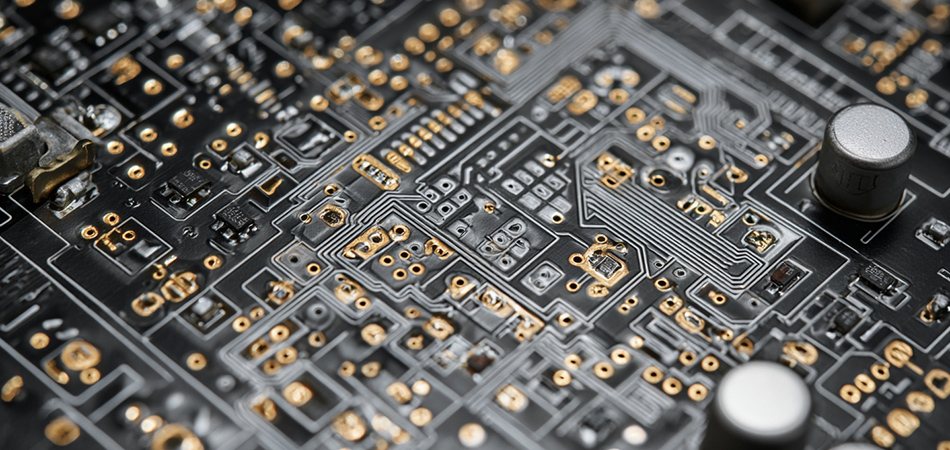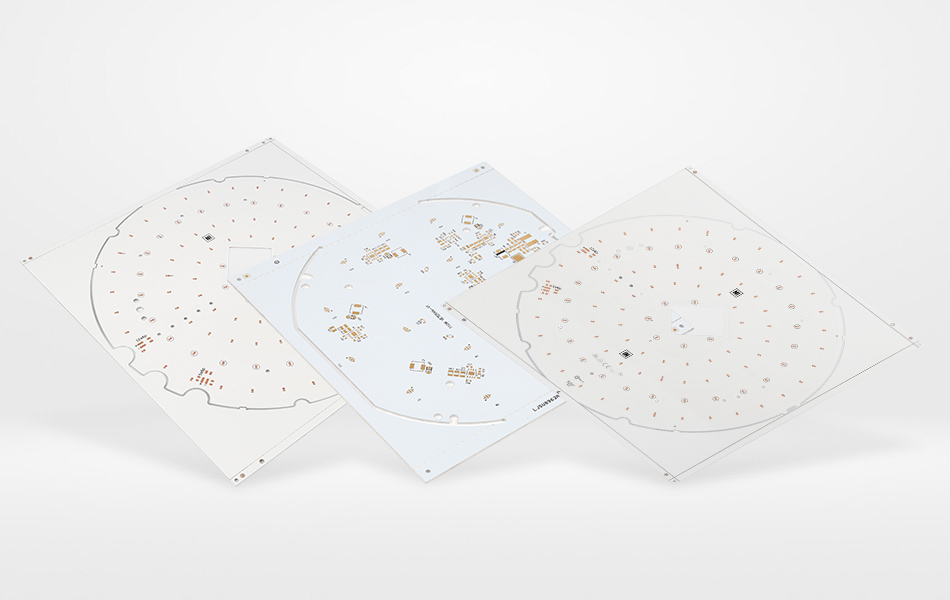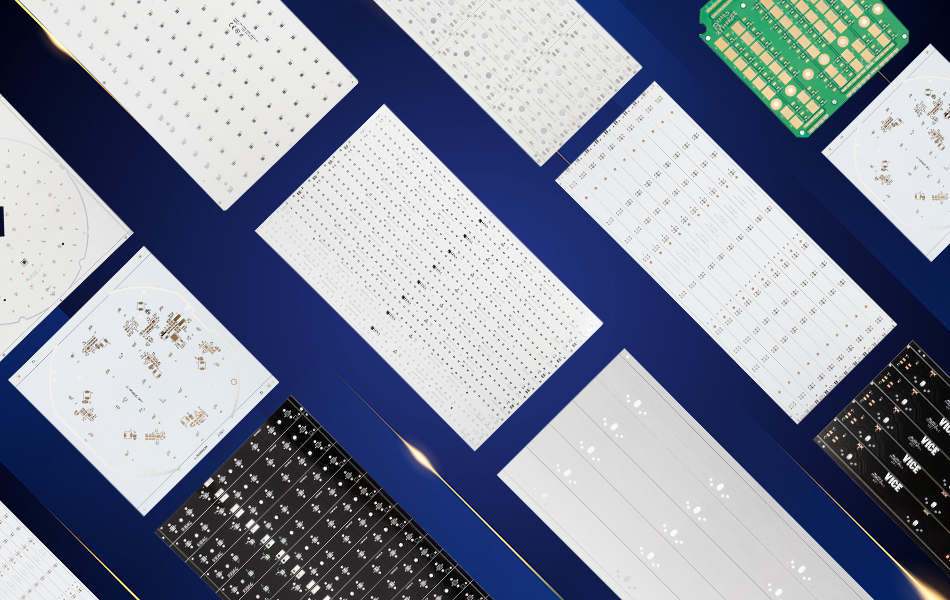-
- PCB TYPE
- PRINTED CIRCUIT BOARD PROTOTYPE ALUMINUM PRINTED CIRCUIT BOARD R&F PCB FPC HIGH FREQUENCY PCB HIGH-TG PCB HEAVY COPPER PCB HDI PCB PCB FOR LIGHTING METAL CORE PCB
time:Jul 14. 2025, 10:51:47
Aluminum printed circuit boards (PCBs) have transcended their role as niche thermal management solutions to become foundational components in diverse electronic systems. By merging the mechanical resilience of aluminum with advanced conductive and insulating materials, these PCBs address the critical challenges of power density, miniaturization, and environmental sustainability. This article explores the latest advancements in aluminum PCB technology, focusing on material innovations, design breakthroughs, and emerging applications that are reshaping industries from consumer electronics to renewable energy.
Material Science Evolution in Aluminum PCBs
Next-Generation Aluminum Alloys
Recent developments in aluminum alloy formulation have expanded the performance envelope of aluminum PCBs:
High-Strength, High-Conductivity Alloys: New 6xxx series variants, engineered with optimized magnesium and silicon ratios, offer 15% higher thermal conductivity than traditional alloys while maintaining mechanical strength. These alloys are ideal for high-power applications like electric vehicle (EV) motor controllers, where heat dissipation and structural integrity are equally critical.
Corrosion-Resistant Composites: Aluminum cores infused with ceramic particles (e.g., alumina) exhibit enhanced resistance to moisture and chemicals, making them suitable for marine electronics and industrial sensors exposed to harsh environments.
Lightweight Alloys for Portable Devices: Advanced 1xxx series alloys, refined for ultra-low density, reduce PCB weight by up to 20% compared to standard aluminum cores, enabling sleeker designs in wearable health monitors and foldable smartphones.
Dielectric Materials: Beyond Traditional Insulation
Innovations in dielectric layers are redefining aluminum PCB capabilities:
Nano-Reinforced Polymers: Dielectrics embedded with carbon nanotubes or graphene platelets achieve thermal conductivity exceeding 5 W/mK—double that of conventional ceramic-filled epoxies—without sacrificing electrical insulation. These materials are revolutionizing heat transfer in high-frequency devices like 5G mmWave transceivers.
Self-Healing Dielectrics: Bio-inspired materials with microcapsule-based healing agents can repair small cracks caused by thermal cycling, extending PCB lifespan in critical applications such as aerospace avionics.
Low-Loss, High-Temperature Dielectrics: Modified polyimides with glass transition temperatures (Tg) above 300°C maintain stability in extreme environments, from industrial furnaces to deep-space probes, where traditional materials would degrade.
Copper Integration: Advanced Conductive Solutions
Copper layers in modern aluminum PCBs are engineered for versatility:
Graphene-Coated Copper: Thin graphene overlays on copper traces reduce surface resistance by 20%, enhancing signal integrity in high-speed digital circuits (e.g., PCIe 6.0 interfaces).
Flexible Copper Foil: Annealed copper with microstructural modifications withstands repeated bending in flexible aluminum PCBs, enabling curved designs in automotive dashboards and wearable fitness trackers.
Selective Plating Techniques: Laser-activated plating allows copper to be deposited only where needed, reducing material waste and enabling finer trace geometries in dense integrated circuits.

Design Paradigms Shaping Aluminum PCB Development
AI-Driven Design Optimization
Artificial intelligence is transforming aluminum PCB design workflows:
Predictive Thermal Modeling: Machine learning algorithms analyze component placement and layer configurations to simulate heat distribution, identifying hotspots before prototyping. This reduces design cycles by up to 40% in complex systems like server motherboards.
Generative Design Tools: AI generates optimal trace routing and via placement, balancing signal integrity and thermal performance. For example, in automotive radar modules, these tools minimize EMI by 30% compared to manual designs.
Real-Time Material Selection: AI systems recommend alloy-dielectric combinations based on application requirements (e.g., high vibration vs. extreme temperature), ensuring optimal performance while reducing over-engineering.
3D and Conformal Design Approaches
Aluminum PCBs are moving beyond flat, rigid structures:
3D-Molded Aluminum Cores: Press-forming techniques create complex 3D shapes, integrating cooling fins directly into the aluminum substrate for applications like LED projectors, eliminating the need for separate heat sinks.
Conformal Electronics: Thin aluminum foils bonded to flexible dielectrics enable PCBs that conform to curved surfaces, such as drone wings or industrial pipe sensors, where traditional rigid PCBs cannot fit.
Heterogeneous Integration: Embedding passive components (resistors, capacitors) within aluminum cores reduces board size by 25% in IoT devices, while maintaining thermal conductivity through the metal substrate.
Multi-Physics Optimization
Modern design methodologies address overlapping performance demands:
Thermal-Electrical Co-Simulation: Tools simulate how current density in copper traces affects heat generation, enabling simultaneous optimization of power distribution and thermal management in EV chargers.
Mechanical-Thermal Coupling Analysis: Finite element analysis (FEA) models predict how thermal expansion of aluminum cores interacts with solder joint fatigue, critical for ensuring reliability in aerospace PCBs subjected to extreme temperature cycles.

Manufacturing Breakthroughs in Aluminum PCB Production
Automated and Intelligent Fabrication
Advancements in manufacturing are enhancing precision and efficiency:
Robotic Lamination Systems: Automated arms with vision systems ensure uniform dielectric bonding to aluminum cores, reducing layer-to-layer variation in thermal conductivity by 15% compared to manual processes.
In-Line Quality Sensing: Infrared cameras and AI-powered inspection tools detect delamination or voids in real time during lamination, reducing scrap rates in high-volume production (e.g., LED lighting PCBs).
Adaptive Etching Processes: Machine learning adjusts etchant concentrations and dwell times based on aluminum alloy type, ensuring consistent trace geometry across production runs.
Additive Manufacturing for Customization
3D printing is enabling unprecedented design freedom:
Direct Metal Deposition: Laser-based systems print aluminum cores with integrated cooling channels, tailored to specific heat loads in devices like high-power RF amplifiers.
Hybrid Printing: Combining 3D-printed aluminum structures with printed copper traces eliminates traditional lamination steps, reducing production time for low-volume, high-complexity PCBs (e.g., medical imaging equipment).
Sustainable Manufacturing Practices
Eco-friendly processes are redefining aluminum PCB production:
Closed-Loop Aluminum Recycling: Scrap aluminum from PCB manufacturing is reprocessed into new substrates with 95% of the original thermal conductivity, reducing raw material consumption.
Waterless Etching: Plasma etching techniques replace chemical baths, eliminating hazardous waste in copper patterning steps for consumer electronics PCBs.
Renewable Energy Integration: Solar-powered factories for aluminum PCB production reduce carbon footprints by up to 30%, aligning with global sustainability goals in the electronics industry.

Emerging Applications Across Industries
Quantum Computing Infrastructure
Aluminum PCBs play a critical role in quantum processors:
Cryogenic Compatibility: Aluminum’s low thermal expansion at near-absolute-zero temperatures (used in quantum cooling systems) prevents signal distortion in superconducting qubit circuits.
Shielded Enclosures: Aluminum cores integrated with electromagnetic shielding layers protect sensitive quantum signals from external interference, essential for maintaining qubit coherence.
Hydrogen Energy Systems
Aluminum PCBs are enabling the hydrogen economy:
Fuel Cell Controllers: Corrosion-resistant aluminum alloys with ceramic dielectric layers manage high currents in hydrogen fuel cell stacks, withstanding humid, hydrogen-rich environments.
Hydrogen Sensor PCBs: Aluminum cores dissipate heat from sensor electronics, ensuring accurate detection of hydrogen leaks in industrial storage facilities.
Advanced Robotics and Automation
Aluminum PCBs support next-generation robotic systems:
Collaborative Robot Joints: Flexible aluminum PCBs with strain-resistant copper traces handle continuous motion in robotic arms, maintaining signal integrity during millions of bending cycles.
Autonomous Vehicle Compute Modules: High-power aluminum PCBs with multiple copper layers manage the processing demands of LiDAR, radar, and camera systems, with thermal conductivity ensuring reliable operation in vehicle engine bays.
Space and Satellite Electronics
Aluminum PCBs are critical for space-rated systems:
Radiation Hardening: Aluminum cores with specialized dielectric layers resist damage from cosmic radiation, ensuring functionality of communication satellites in geostationary orbit.
Lightweight Power Distribution: Thin aluminum PCBs reduce launch weight in small satellites (CubeSats), while maintaining the thermal management needed for solar panel power conversion.

Sustainability and Circular Economy in Aluminum PCB Lifecycle
End-of-Life Recycling Innovations
Aluminum PCBs are leading in electronic waste (e-waste) solutions:
Selective Delamination: Thermal and chemical processes separate aluminum cores from copper and dielectric layers, enabling 90% recycling of aluminum for new PCB production.
Copper Recovery: Hydrometallurgical techniques extract copper from etched scrap with 95% purity, reducing reliance on virgin copper mining.
Low-Carbon Production Pathways
Manufacturers are reducing environmental impact:
Low-Temperature Lamination: New adhesives enable bonding aluminum cores and dielectric layers at 120°C (down from 180°C), cutting energy use in manufacturing by 30%.
Carbon-Neutral Aluminum Sourcing: Partnerships with renewable energy-powered smelters ensure aluminum cores have a near-zero carbon footprint, appealing to eco-conscious industries like electric mobility.
Longevity and Reliability as Sustainability Drivers
Aluminum PCBs contribute to sustainability through extended lifespans:
Corrosion-Resistant Designs: Aluminum cores with anodized surfaces extend PCB life in outdoor applications like smart streetlights, reducing replacement frequency and e-waste.
Overhaul-Friendly Construction: Modular aluminum PCB designs allow component replacement without discarding the entire board, common in industrial control systems where longevity is valued.

Future Trends and Industry Impact
Material Convergence
Aluminum-Graphene Hybrids: Research into aluminum matrices infused with graphene promises 50% higher thermal conductivity, targeting applications in high-performance computing (HPC) data centers.
Bio-Based Dielectrics: Plant-derived polymers, such as those made from castor oil, are being developed as sustainable alternatives to petroleum-based dielectrics, with comparable thermal and electrical properties.
Smart Aluminum PCBs
Embedded Sensing: Aluminum cores with integrated strain gauges monitor PCB health in real time, enabling predictive maintenance in critical systems like nuclear power plant controllers.
Energy Harvesting: Thermoelectric materials bonded to aluminum PCBs convert waste heat into electricity, powering low-energy sensors in industrial machinery.
Industry Disruption
Cost Parity with Traditional PCBs: Advances in manufacturing automation are bringing aluminum PCB costs closer to FR4, expanding adoption in consumer electronics like smart TVs and gaming consoles.
Supply Chain Resilience: Regional production of aluminum PCBs, leveraging local aluminum supplies, reduces reliance on global supply chains, a key advantage in post-pandemic manufacturing strategies.
Conclusion
Aluminum PCBs have evolved into dynamic, multi-functional components that drive innovation across electronics. Their ability to balance thermal efficiency, mechanical durability, and design flexibility makes them indispensable in emerging technologies, from quantum computing to green energy systems. As material science, manufacturing, and design methodologies continue to advance, aluminum PCBs will play a pivotal role in addressing the industry’s most pressing challenges: sustainability, miniaturization, and reliability. For engineers and manufacturers, embracing these advancements is not just a technical necessity but a strategic imperative to create the next generation of high-performance, eco-friendly electronic systems.

Got project ready to assembly? Contact us: info@apollopcb.com



We're not around but we still want to hear from you! Leave us a note:

Leave Message to APOLLOPCB
